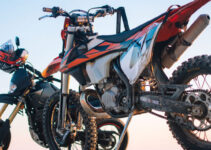Riding a dirt bike in deep sand can be challenging, but with the right techniques and preparation, you can navigate sandy terrains more effectively. Riding a dirt bike in deep sand requires specific techniques and preparations to tackle the challenging ground effectively.
How to prepare dirt bike for deep sand riding?
1. Proper Tire Selection
Selecting the appropriate tires for riding a dirt bike in deep sand is crucial for optimal performance. When choosing tires, look for designs specifically engineered for sandy Land. The best tires for deep sand are wide; these tires provide more surface area to contact the sand.
2. Adjust Your Suspension
When riding a dirt bike in deep sand, adjusting your suspension to provide more travel and a softer ride is important. This will help prevent the bike from bottoming out and make it easier to control. In deep sand, the bike tends to sink and encounter irregular terrain, requiring specific suspension settings
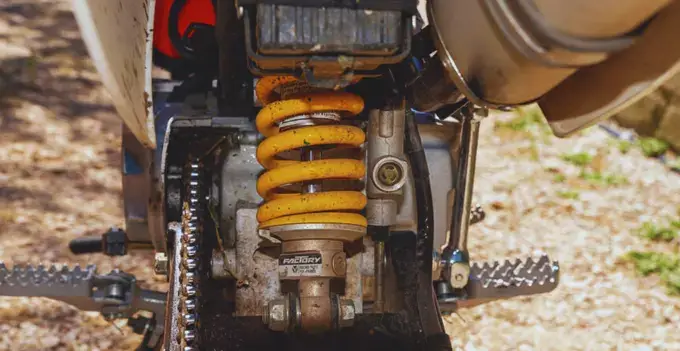
3. Shift Your Weight Back
When riding a dirt bike in deep sand, it is important to shift your weight back. This will help keep the front wheel from digging into the sand and make it easier to control the bike.
To shift your weight back, you will need to:
- Lean back on the seat.
- Put your weight on your back foot.
- Grip the handlebars with your knees.
4. Use the Throttle Smoothly
When riding a dirt bike in deep sand, it is important to use the throttle smoothly. This will help prevent the bike from spinning out and make it easier to control. To use the throttle smoothly, you must gradually open it and keep it steady as you ride through the sand.
5. Use the Brakes sparingly.
When riding a dirt bike in deep sand, it is important to use the brakes sparingly. This is because braking will cause the tires to dig into the sand, making it harder to control the bike. If you need to brake, use the rear brake only and apply it gently. Braking too hard will cause the rear wheel to skid, and you will lose control.
6. Be Prepared to Fall
That’s a good point. It’s important to be prepared to fall when riding a dirt bike, no matter how experienced you are. This includes a helmet, goggles, gloves, chest protectors, knee and elbow pads. Practice riding in a safe area; this will help you get a feel for how the bike handles and reacts in different situations.
How Do You Handle a Dirt Bike on Sand?
Riding a bike on sand can be a fun and challenging experience. However, it can also be frustrating if you need to learn how to handle your bike properly. Slow down; the faster you go, the more likely you will sink into the sand. Shift to a lower gear; This will give you more torque and help you pedal through the sand. Lean back; This will help to keep your front wheel from digging into the sand. Use a wider tire because a wider tire provides a wider area to grip the sand. Avoid breaking because it can lead tires to dig into the sand and become more difficult to control.
Is Riding a Dirt Bike in Sand Hard?
Yes, riding a dirt bike in the sand can be hard. The sand is loose and soft, which makes it difficult for the tires to get a grip. This can make it difficult to control the bike and can lead to crashes. Riding a dirt bike in sand presents unique challenges due to the unstable and shifting nature of the Land.
The loose surface reduces traction, causing the wheels to spin and the bike to feel less responsive to steering inputs. Riders must adapt their techniques, such as body positioning and throttle control, to navigate the sand effectively.
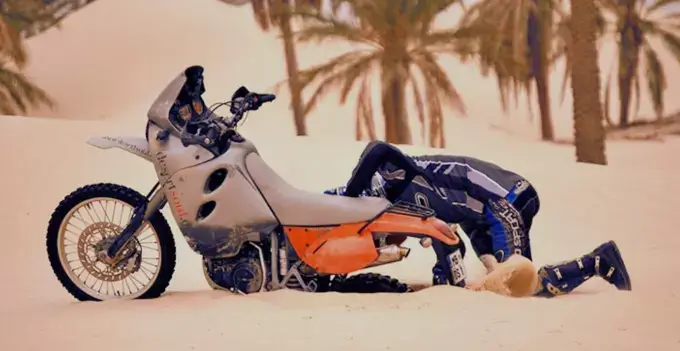
Dirt Bike Sand Riding Tips
When riding a dirt bike in sandy conditions, here are some helpful tips to improve your performance and enjoyment:
i) Body Position
In sand riding a dirt bike, mastering the proper body position is important for maintaining control and stability. Stand up on the footpads, gripping the bike with your knees to provide stability and control. Shift your body weight towards the front, keeping your elbows up and slightly bent. This forward-leaning position helps keep the front wheel planted and improves traction.
ii) Lower Tire Pressure
Yes, lowering the tire pressure of your dirt bike can help you ride in the sand more easily. This is because a lower tire pressure will make the tires more flexible, which will help them to conform to the sand and provide more traction. If your ideal pressure is 2.2 bar in the front and 2.5 bar in the rear, in the case of sandy conditions, it can go down to 1 bar or even 0.9 bar.
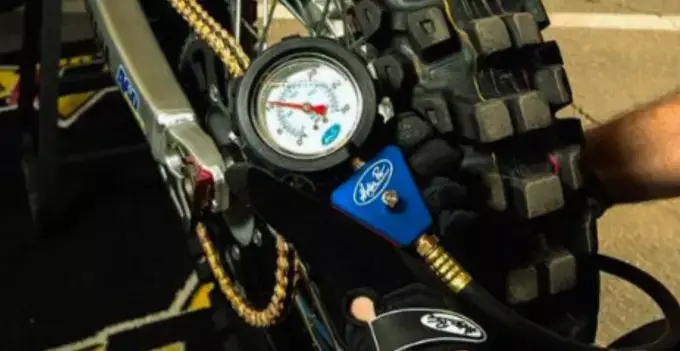
iii) Steady Speed
Keeping the bike vertical and controlling your momentum is the key to maintaining a steady speed in the sand. If you start to sink, give it a little more throttle to get back up. And if you start to wobble, shift your weight to the downhill side to help stabilize the bike. You’ll be riding in the sand like an expert with a little practice.
iv) Practice and Practice
Practice makes a man perfect. Practice and practice are important keys to mastering these challengings. One of the best ways to practice sand riding is to find a safe area with various terrain to challenge yourself. You can start by practicing starting and stopping, then move on to cornering and braking.
Will Sand Ruin a Dirt Bike?
Sand can be very irritating and damage a dirt bike’s components if it gets into the engine, air filter, or other moving parts. However, it is not likely to ruin a dirt bike in a single ride. If you’re riding in sand frequently, having your dirt bike regularly inspected by a qualified mechanic is a good idea to ensure the sand is not causing any damage.
Here are some tips to help keep sand out of your dirt bike:
- Use a good-quality air filter
- Keep the air filter clean and oiled
- Use a mudguard to keep sand from splashing up onto the engine
- Clean the dirt bike thoroughly after riding in the sand.
Post-Ride Cleaning Tip
Post-ride cleaning is essential to keep your dirt bike in good condition. Sand is very abrasive and can damage the components of your bike if it is not cleaned immediately after riding.
✦ Cool Down the Engine
Before you start cleaning your dirt bike, it’s essential to cool down the engine. This will help prevent damage to the engine and ensure the cleaning process is more effective. You can cool down the engine by letting it idle for a few minutes or by riding it slowly until it cools down. Once the engine has cooled down, you can start cleaning your dirt bike.
✦ Remove the Spark Plug
After riding in the sand, removing the spark plug and cleaning it is required. This will help remove any sand or dirt entering the cylinder. You can remove the spark plug by using a spark plug wrench. Once the spark plug is removed, you can clean it with a wire brush or cleaner. Be sure to reinstall the spark plug correctly.

✦ Clean the Air Filter
One of the most important post-riding cleaning tips is to clean the air filter. A dirty air filter can restrict airflow to the engine, which can cause it to run poorly or even overheat. If the air filter is severely dirty, you may need to replace it. A new air filter will ensure your engine gets clean air to run properly.
✦ Clean the Chain
Cleaning the chain of your dirt bike is a crucial step in post-ride maintenance. To start, removing any excess dirt and debris from the chain is important by using a stiff brush or a chain cleaning tool. Rotate the wheel manually while holding the brush against the chain to ensure cleaning.
✦ Lubricate the Moving Part
Your bike’s moving parts are constantly rubbing against each other, and without lubrication, they will wear out before the due time. You can lubricate the moving parts of your bike by using a good-quality lubricant. Be sure to apply the lubricants to all the moving parts, such as bearings, pivot points, and linkages.
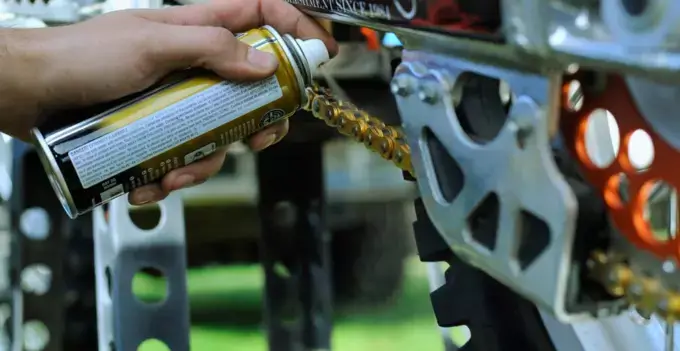
How to Prep Your Dirt Bike for the Sand Dunes?
Preparing your dirt bike for dunes requires careful attention to ensure the best performance and protection in this unique riding environment. Adjusting the tire pressure and lower tire pressure can enhance control and stability. Installing sand-specific tires with wide paddle-like treads can improve grip in loose sand.
Protecting air filters from sand particles that can cause engine damage is also crucial. Moreover, consider applying a protective coating, such as silicone spray or WD-40, to exposed metal parts to minimize corrosion from sand and saltwater exposure. To prevent overheating in dunes, ensure the bike cooling system is in top condition by cleaning the radiator and coolant level.
Dangers of Riding a Dirt Bike in Dunes
Being aware of the danger while riding dirt bikes in dunes is important. The soft sand can make it difficult to control the bike, and you can easily lose control and crash if you’re not careful. Sand can also get into the air filter and engine, causing damage. In addition, dunes can be very remote, so if you have an accident, it may not be easy to get help.
✦ Loss of Control
Controlling the dirt bike can be easier if you’re riding too fast on the dunes. If the sand is too soft or loose, it can be difficult to control the traction. If the ground is rough or there’re obstacles, controlling the bike can be more difficult.
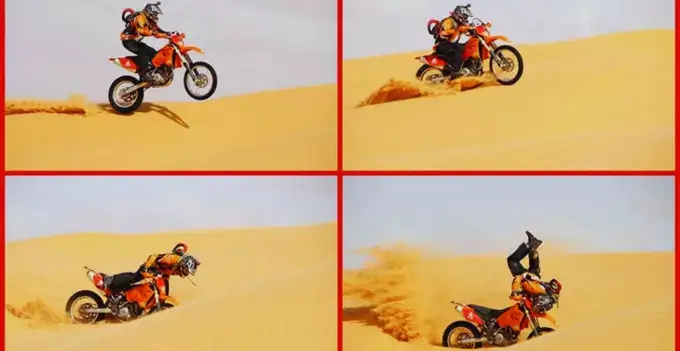
✦ Overheating
Overheating is a danger associated with riding a dirt bike on dunes. The soft sand can make it difficult for the bike’s cooling system to function properly, and if the engine overheats, it can seize up or even catch fire. This can lead to serious injuries or even death.
✦ Exhaustion and Dehydration
A dirt bike in dunes can pose significant risks, including exhaustion and dehydration. The demanding nature of riding on sandy Land requires more physical effort as compared to other surfaces. The bike can become harder to control, requiring constant body adjustments and movement to maintain balance.
✦ Collisions and Visibility
Riding a dirt bike in dunes comes with basic dangers, including collisions and visibility dangers. Riding at a safe speed and maintaining a high level of attention to avoid collisions is crucial. Riding with a group of riders increases the risk of collision, especially when visibility is limited.
Dirt Bike Riding Tips for Beginners
For beginners, it is crucial to get proper training and practice to become professional; otherwise, it can be dangerous. Starting with a smaller bike will be easier, especially for beginners. Taking a dirt bike safety course is essential to learn the basics of riding a dirt bike in the sand dunes. Wear safety guards, which include a helmet, goggles, gloves, boots, and long pants.
The most important tip for beginner dirt bike riders is to get proper exercise to control the bike in sand dunes. It includes stretching, core strength, leg strength, balance, and flexibility. Getting practice in the sand dunes is also important to overcome the dan-dangers.

FAQs
What are the Best Dirt Bikes for Sand?
Here are the best dirt bikes for sand dunes:
- KTM 300 XC-W
- Yamaha YZ450F
- Honda CRF450X
- Beta 300 RR-S
Which Tire is Best for Sand Dunes?
The best dirt bike tire for dunes is a paddle tire. Paddle tires have deep lugs that help to dig into the sand and provide traction, such as Maxxis MaxxCross MA3, SunF MX-11, Goldentyre Sandmaster, and Dunlop AT81.
How to Adjust Dirt Bike Gearing for Sand Dunes?
Adjusting your dirt bike gearing for dunes is a relatively simple process. The goal of adjusting your gearing is to find a combination of front and rear gearwheel sizes that will give you the right amount of torque and acceleration for the type of sand you will be riding in.

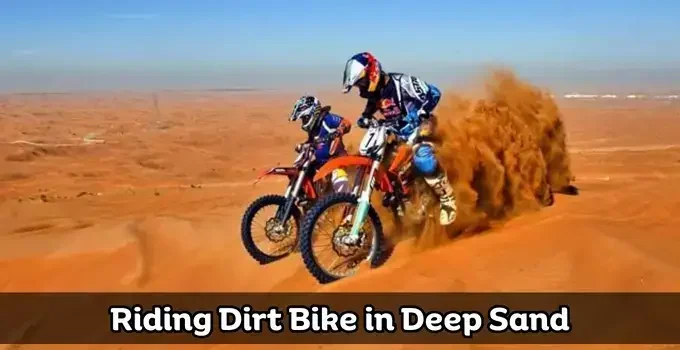
![Dirt Bike Braking Tips And Techniques [Stop Dirt Bike Safely] Dirt Bike Braking Tips And Techniques [Stop Dirt Bike Safely]](https://dirtbikecoach.com/wp-content/uploads/2022/08/Dirt-Bike-Braking-Tips-211x150.png)


